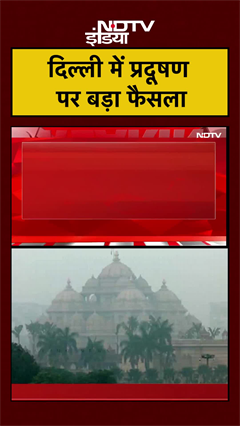- Home/
- 1.5 Million People Die Every Year Due To PM 2.5 Air Pollution: Report
1.5 Million People Die Every Year Due To PM 2.5 Air Pollution: Report

Fine pollution particles (PM2.5) may be responsible for 1.5 million additional premature deaths around the globe each year, according to a study which found that low levels of air pollution are dangerous than previously thought.
The World Health Organization's most recent estimates are that over 4.2 million people die prematurely each year due to long-term exposure to fine particulate outdoor air pollution referred to as PM2.5.
The latest study, published in the journal Science Advances, suggests that the annual global death count from outdoor PM2.5 may be significantly higher than previously thought.
That is because the researchers found that mortality risk was increased even at very low levels of outdoor PM2.5, which had not previously been recognised as being potentially deadly.
These microscopic toxins cause a range of cardiovascular and respiratory diseases and cancers.
"We found that outdoor PM2.5 may be responsible for as many as 1.5 million additional deaths around the globe each year because of effects at very-low concentrations that were not previously appreciated," said Scott Weichenthal, Associate Professor at McGill University in Canada and the lead author on the paper.
The researchers combined health and mortality data for seven million Canadians gathered over a twenty-five-year period with information about the levels of outdoor PM2.5 concentrations across the country.
Canada is a country with low levels of outdoor PM2.5, making it the perfect place to study health impacts at low concentrations.
Knowledge gained in Canada was then used to update the lower end of the scale that is used to describe how mortality risk changes with outdoor PM2.5 levels.
The study found an improved understanding of how air pollution impacts health on a global scale.
The WHO recently set out ambitious new guidelines for annual average outdoor fine particulate air pollution, cutting its earlier recommendations in half, from concentrations of 10 to 5 microgrammes (ug) per cubic metre.
"One take away is that the global health benefits of meeting the new WHO guideline are likely much larger than previously assumed," said Weichenthal.
"The next steps are to stop focussing only on particle mass and start looking more closely at particle composition because some particles are likely more harmful than others," he added.
A better understanding may allow us to be much more efficient in designing regulatory interventions to improve population health, the researchers added. PTI SAR SAR
(Except for the headline, this story has not been edited by NDTV staff and is published from a syndicated feed.)
also read
"Changing Excuses Every Year": Rahul Gandhi Slams BJP Over Delhi's Toxic Air, Party Responds
Reported by Ishika VermaDelhi's Air Quality Remains In 'Very Poor' Category, AQI Recorded At 309
Asian News InternationalStubble Burning In Punjab, Haryana Reduced By 50% This Year: Top Expert To NDTV
Reported by Himanshu Shekhar Mishra, Edited by Manjiri Chitre
Latest Stories
- Reported by Ishika Verma | Tuesday November 04, 2025 , New Delhi
"Now that the BJP rules both at the Centre and in Delhi, there can be no more excuses," Rahul Gandhi said in a social media post.
- Asian News International | Tuesday November 04, 2025 , New Delhi
The air quality in the national capital continued to remain in the 'very poor' category on Tuesday morning, with the Air Quality Index (AQI) recorded at 309 at 7 am, according to the Central Pollution Control Board (CPCB).
- Reported by Himanshu Shekhar Mishra, Edited by Manjiri Chitre | Tuesday November 04, 2025 , New Delhi
A total of 4,754 stubble burning incidents were recorded in Punjab and Haryana between September 15 and November 2 last year. This year, it has dropped to 2,384.
- Monday November 03, 2025 , New Delhi
A thick layer of haze enveloped the national capital on Monday, with the air quality remaining in the "very poor" category and very likely to deteriorate to "severe" on Tuesday.
- Indo-Asian News Service | Monday November 03, 2025 , New Delhi
The Supreme Court on Monday asked the Commission for Air Quality Management to file an affidavit detailing the measures undertaken to prevent Delhi-NCR's air quality from deteriorating.
................................ Advertisement ................................
Latest Videos
Opinion
Opinion | Why Indians Have Just Given Up On Air Pollution CrisisTanushree Ganguly
Friday December 20, 2024While some may argue that people in Delhi are now more aware of air pollution than they were a decade back, my rebuttal would be that awareness does not mean that people are concerned.
Opinion | You Must Outrage Over Filthy Air More Than Once A YearJyoti Pande Lavakare
Tuesday December 10, 2024Delhi welcomed us with monsoon rains and mangos. We were home. Fast forward a couple of years, in the winter of 2012, I found myself in denial about something other parents, mostly expats, were calling toxic air.
Opinion | Delhi's Air Pollution Situation Is Like A Bad MarriageNishtha Gautam
Friday November 22, 2024On a good day, such as today, the AQI reading in Delhi is 407. We are jubilant at the sickly sunshine trickling through the slightly dissipated smog. At least its not 1600.
दिवाली... पराली... सियासी जुगाली!Ashwini kumar
Monday November 18, 2024दिल्ली-एनसीआर में प्रदूषण का समाधान तो आज तक मिला नहीं. हर साल चिंतित होकर हम-आप सांसों की तकलीफ के साथ-साथ दिल और ब्लड प्रेशर के मरीज भी क्यों बनें?
घर में कैद बुजुर्ग और हांफते लोग, दिल्ली की सांसों में घुला ये कैसा रोग?Nidhi Kulpati
Friday November 08, 2024हमारी हवा जहरीली हो रही है. गुरुवार की शाम को जब मैं इस मुद्दे पर लिखने बैठी तो AQI लगातार 400 पार जाकर दम घोंट रहा था. बहुत लोगों को यह मामला बोरिंग लगे, लेकिन जब आप अपने साथ काम करने वालों को खांसते-हांफते देखते-सुनते हैं, तो चिंता होने लगती है. सुबह उठते ही दरवाजे खिड़कियां खोलने के लिए डॉक्टर मना कर रहे हैं. बड़े बुजुर्गों के लिए तो मॉर्निंग वॉक बाहर की दुनिया से सीधे संपर्क का ज़रिया है, लेकिन डॉक्टर इसकी भी मनाही कर रहे हैं.


















